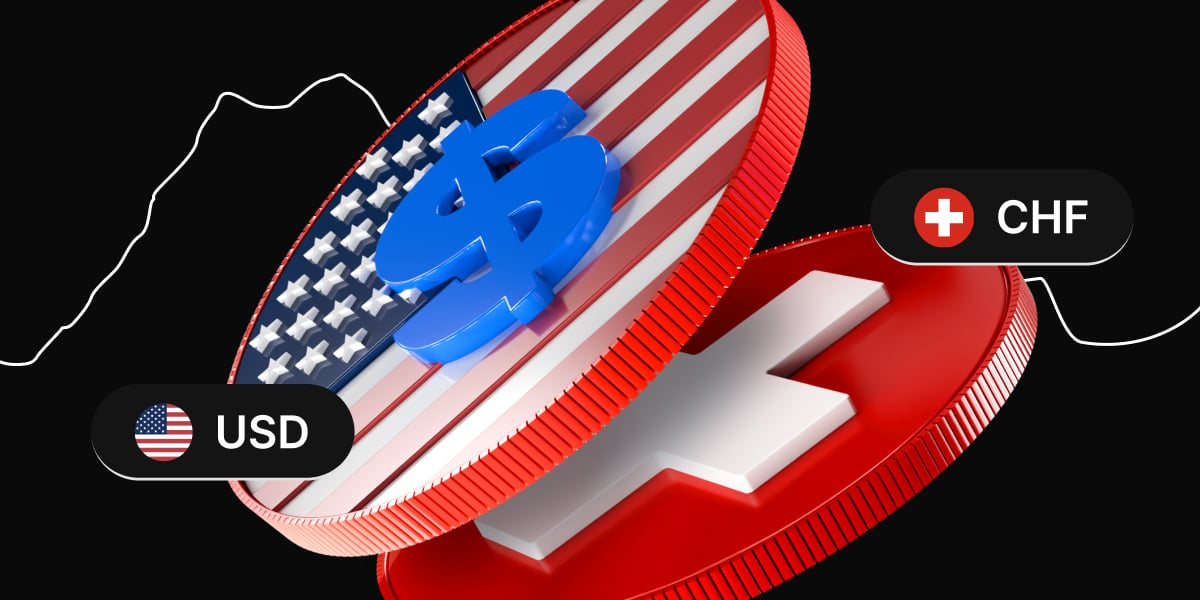Day trading is an active form of trading where traders buy and sell financial instruments within the same trading day. This method requires precision, strategy, and the ability to make quick decisions. With the rise of online trading platforms and remote work, more individuals are interested in exploring the world of day trading.
This comprehensive guide will cover the fundamentals of day trading, the best trading strategies, risk management techniques, and FAQs to help you succeed in the fast-paced world of trading.
What Is Day Trading?
Day trading involves executing multiple trades in a single day to capitalize on short-term price movements. Traders typically use technical analysis, charts, and various indicators to make informed decisions.
Key Aspects of Day Trading:
- Focuses on intraday price movements.
- Requires rapid execution and decision-making.
- Often employs leverage to amplify gains.
- Uses technical analysis rather than fundamental analysis.
Best Day Trading Markets
Different markets offer unique advantages for day traders. The most commonly traded assets include:
| Market | Characteristics |
|---|---|
| Forex | High liquidity, 24-hour market, leverage available |
| Stocks | High volatility, earnings reports impact prices |
| Cryptocurrencies | 24/7 trading, extreme volatility |
| Commodities | Trends follow global economic events |
| CFDs (Contracts for Difference) | Trade price movements without owning the asset |
How Does Day Trading Work?
Day trading requires analyzing charts, executing trades, and managing risk—all within short timeframes. The goal is to extract profits from rapid price fluctuations.
Common Day Trading Timeframes:
- 1-Minute (1M) Chart: Ideal for scalping strategies.
- 5-Minute (5M) Chart: Popular among active traders.
- 15-Minute (15M) Chart: Suitable for identifying short-term trends.
- 1-Hour (1H) Chart: Helps confirm larger trends.
Day Trading Strategies
As with any type of trading, technical analysis consisting of chart patterns and indicators can be used to create a successful day trading strategy. The best day trading strategies offer a solid win-loss ratio, regardless of the trading instrument.
These tools can be used to spot trend changes, highlight support and resistance, and much more. Learning how to utilize these tools across multiple smaller timeframes and assets is the key to unlocking profits quickly.
PrimeXBT offers clickable charts via its built-in technical analysis software, complete with over 40 top indicators to use while day trading.
Here are some of the day trading strategies you can create using the indicators offered on PrimeXBT.
RSI Day Trading Strategy
The Relative Strength Index is a technical analysis indicator that tells day traders when assets reach oversold or overbought conditions and measures trend strength and momentum.
The signals it provides are easy to read and can point out when reversals are about to occur. The RSI reaching over 70 or under 30 is typically a good enough signal for most traders to take a position. This can be altered depending on risk appetite and the loss ratio applied to your risk management strategies.
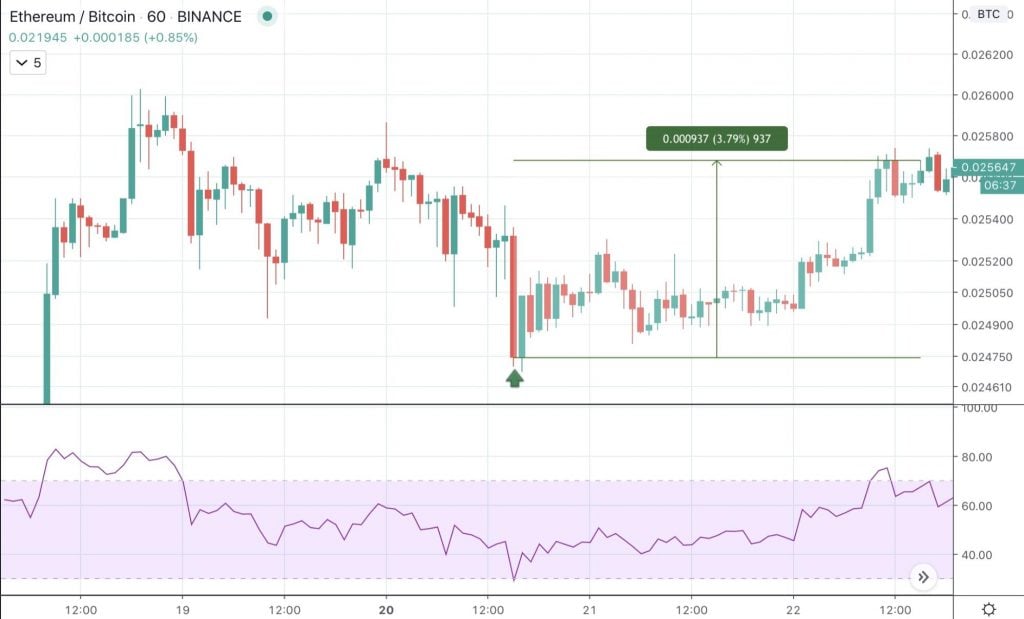
In the above example, the RSI reached oversold levels and below 30 on the gauge it was time to take a long position.
MACD Day Trading Strategy
The MACD, also called the Moving Average Convergence Divergence indicator was created by author and trader Gerald Appel in the late 1960s and is used to help traders predict when trend changes are about to take place.
The MACD consists of two lines and a histogram to visually represent price moves. It is often disregarded as a lagging indicator, that often presents false signals, however, in the right hands the MACD is reliable.
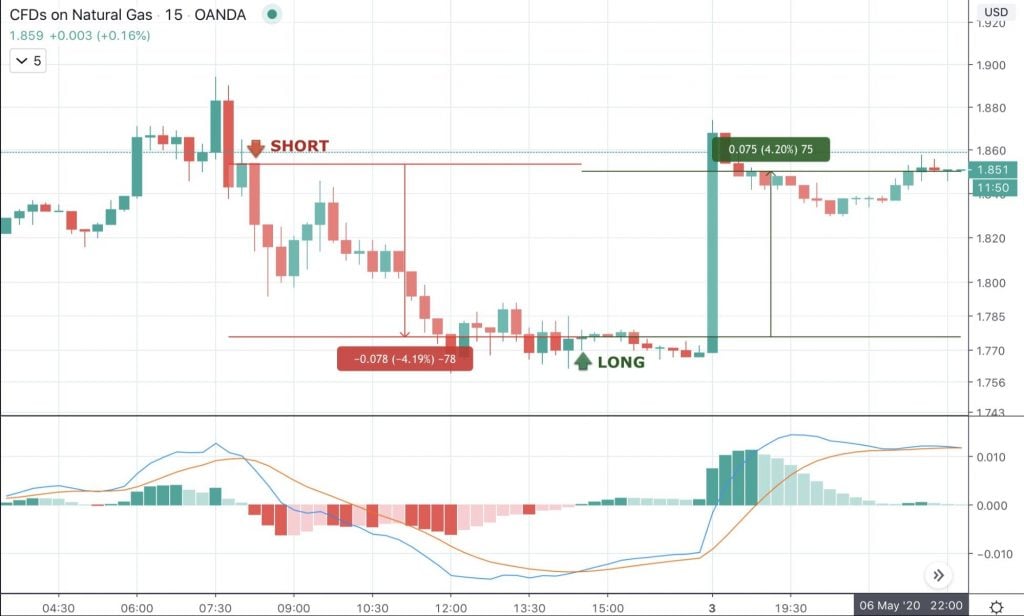
In the above example, a short or long position would be placed the moment the MACD lines cross over and stay open until another crossover occurs.
Parabolic SAR Day Trading Strategy
The Parabolic Stop and Reverse indicator or Parabolic SAR for short, is another lagging indicator like the MACD. However, it is a lot easier to use and offers a simple to understand visual signal system.
Traders use the Parabolic SAR to find potential reversals and gauge trend strength. When combined with other indicators, such as moving averages and others, it can confirm signals and prevent false positives.
Parabolic SAR is also ideal for setting trailing stops, setting each stop loss level increasingly higher or lower depending the direction of the price.
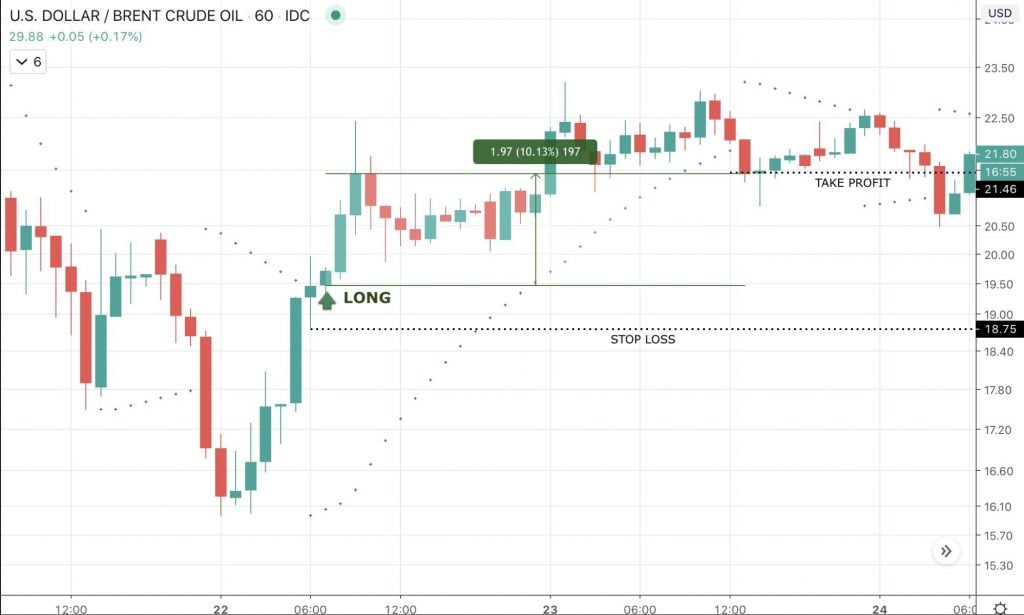
In the above example, a conservative position would be taken the moment the SAR dots appear below price candles. A powerful continuation followed.
Bollinger Bands Day Trading Strategy
Bollinger Bands were created by and named after renowned financial analyst John Bollinger. The tool consists of two plotted standard deviation lines and a simple moving average. The deviation lines widen or narrow depending on the strength of volatility in an asset price.
When the bands tighten, volatility has dropped and an explosive move is overdue.
90% of all price action takes place within the bands, so any deviations outside can be opportunities to take a position. “Riding the bands” can also be a profitable strategy, but only if accompanied by a high volume breakout.
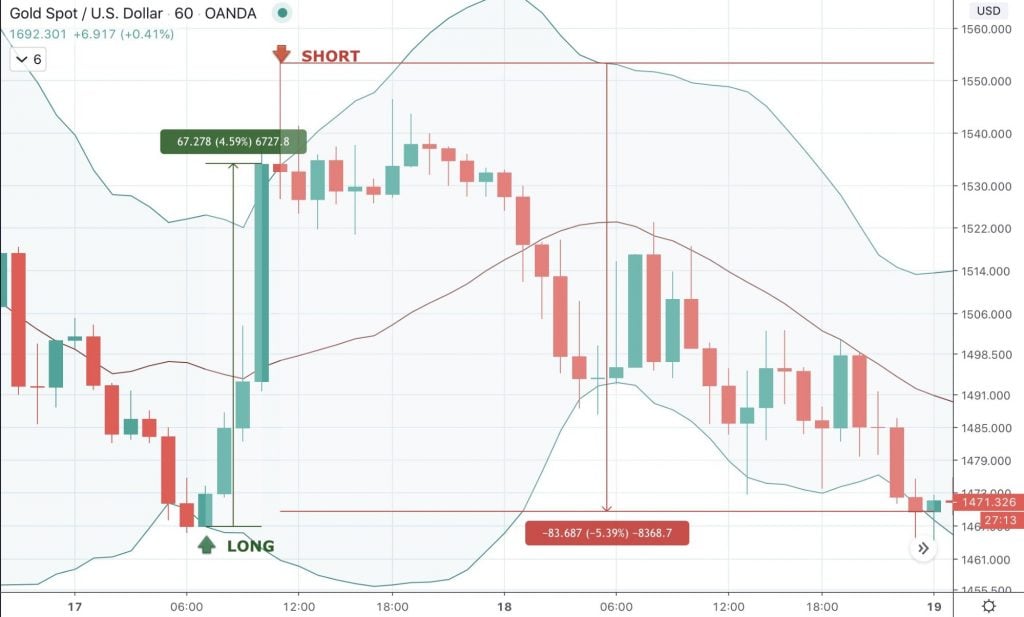
In the above example, a short trade would be opened on the next candle following a candle close outside the bands. This is due to most price action making place within the bands, so it is not unrealistic to expect the price to fall back within the bands after a close outside of them. The trade is then closed when the price closes outside the bands to the downside.
Moving Averages Day Trading Strategy
Moving Averages are simple mathematical formulas designed to provide traders with visual representations of key data points across a series of time periods. Moving averages can run across any time period, long or slow. Experimenting with these time frames are critical to using the tool.
Moving averages consist of nearly every time period and can be adjusted in most cases. The most commonly used moving averages are the 50MA, 100MA, and 200MA, representing long, short, and medium term averages.
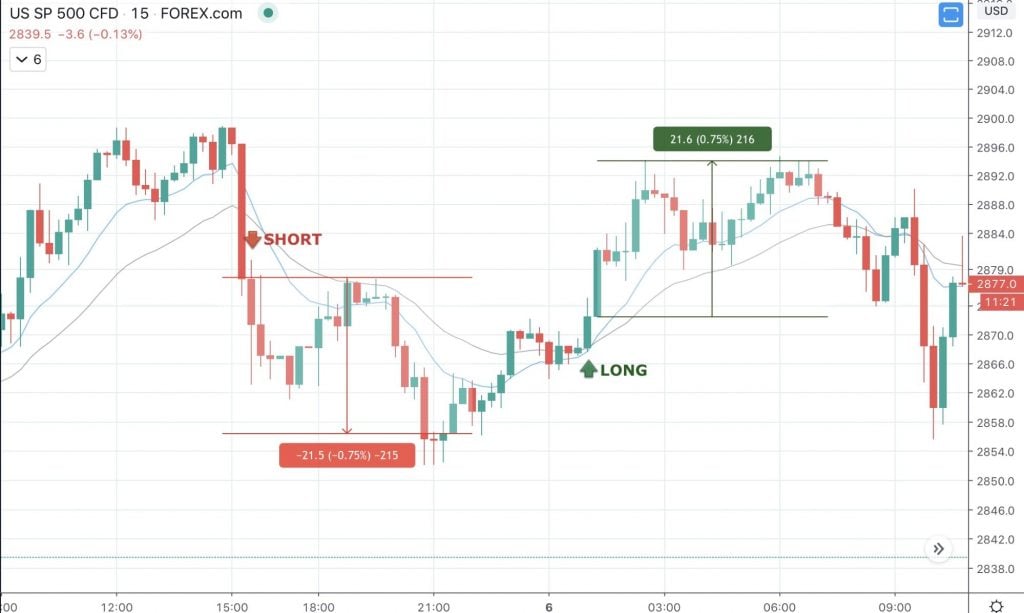
In the above example, each time the price penetrates both lines, it results in a long or short signal. By only taking trades when both lines are breached, you can avoid getting shaken out by a pull back to just one line.
Williams Alligator Day Trading Strategy
Williams Alligator represents an alligator hungry for price action. When there’s a lack of a trend, the alligator is satisfied and its mouth remains closed. But when there’s an active trend, the bands or alligator mouth widens to feed.
How price reacts to these lines and how they crossover or under can provide bearish or bullish signals.
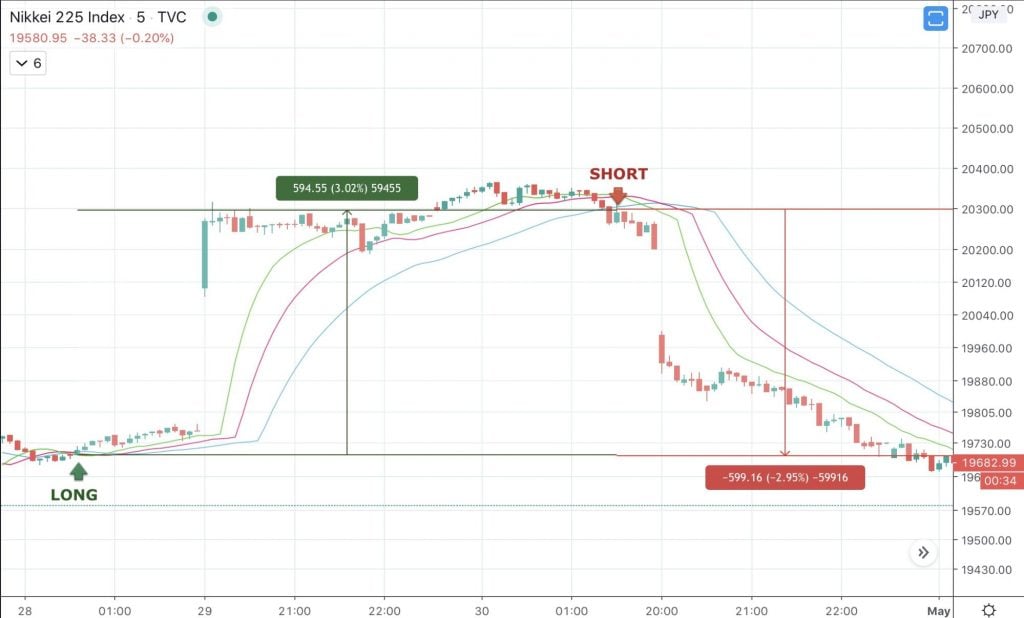
In the above trading strategy using the Williams Alligator indicator, a long or short trade is made the moment price candles close below or above all three price lines.
Ichimoku Day Trading Strategy
The Ichimoku indicator was designed by Japanese journalist Goichi Hosoda in the late 1930s to provide traders with an at a glance visual representation of valuable intel.
The Ichimoku indicator is one of the most complex technical analysis tools available. The amount of signals the tool can provide is near endless, however, the below strategy works best for day trading.

In the above example, a long or short position is opened the moment a candle closes through the cloud to one side.
Day Trading Tips For Beginners
Always pay close attention to risk management strategies and never take position sizes larger than you are comfortable with as it can lead to poor decision making. Successful traders implement strict risk management strategies to protect capital.
1. Set Stop-Loss and Take-Profit Levels
Using stop-loss orders prevents excessive losses, while take-profit orders lock in gains.
2. Risk-Reward Ratio
A common rule is the 1:2 ratio, meaning for every $1 risked, the trader aims to gain $2.
3. Diversification
Traders diversify trades across different assets to reduce overall risk.
4. Trading Journal
Maintaining a trading journal helps track performance, identify strengths, and improve weaknesses.
How to Start Day Trading?
- Choose a Trading Market: Select a market that suits your expertise.
- Develop a Trading Strategy: Backtest strategies before applying them to live trades.
- Open a Trading Account: Choose a reputable broker.
- Start with a Demo Account: Practice before investing real money.
- Monitor and Improve: Continuously analyze and refine your strategies.
Choosing the Right Day Trading Platform
Traders choose PrimeXBT for its unparalleled trading tools and advanced features designed to maximize profitability. With 40+ pro indicators, traders gain precision in technical analysis, allowing for smarter decision-making. The platform offers high leverage (up to 100x), enabling traders to amplify gains while managing risk effectively. Its multi-asset trading capability provides access to Forex, Crypto, Stocks, and Commodities all in one place. Competitive ultra-low fees ensure traders keep more of their profits, while instant execution eliminates slippage, ensuring high-speed order matching. The mobile trading app allows seamless trading on the go, making it convenient for active traders. Additionally, ironclad security ensures institutional-grade protection of funds. With these features, PrimeXBT empowers traders to dominate the markets, whether they’re scalping crypto, trading commodities, or leveraging forex for high returns.
How To Become a Day Trader?
Becoming a day trader is easy and fast, spend some time learning how to day trade online, then find the right platform based on a variety of critical factors. After making your first deposit on the selected platform you can put your skills to the test that you have learned by reading this guide.
How To Learn Day Trading?
There are hundreds of books, podcasts, online resources, training courses and more that offer tons of educational material, tips, ticks and more. Spend time researching the best day trading books, maybe watch some movies for inspiration, or book an online trading course.
How Much Do I Need for Day Trading?
Most margin trading platforms offer very low minimum deposits and size requirements. For example, PrimeXBT requires just 0.001 BTC to get started trading and offers low fees and low minimum positions sizes. Getting started requires very little capital at all.
What Is The Best Platform For Day Trading?
The best day trading platforms offer a wide variety of assets across forex, stock indices, commodities, and cryptocurrencies, along with many advanced trading tools to take advantage of these markets. In addition, the platform should be trusted, reliable, and offer strong security to protect accounts, such as PrimeXBT.
How Much Does The Average Day Trader Make?
There is no limit that the average day trader can make, but it isn’t uncommon to hear of traders earning a full year’s salary in just one month trading. Fortunes have been made, but have also been lost. On average, gain expectations should be kept realistic and modest until more skills are gained.
How To Open a Day Trading Account
PrimeXBT is the ideal platform for day traders due to the wide variety of trading instruments available as CFDs and powerful tools designed for day trading. Low minimum deposits mean that anyone can get started quickly and easily.
The advanced trading platform offers registration in less than 60 seconds. First, click register. Then, enter your preferred email and password. Wait for the confirmation email to arrive, and follow the next steps.
When you return to the platform, confirm your country and log in. You are now ready to make your first deposit.
Deposits can be made to a BTC address from any Bitcoin wallet, or through a third-party service called Changelley that offers additional deposit methods such as fiat or altcoins.
Once the deposit is confirmed, fund your trading account, and begin day trading! If you need further assistance, contact PrimeXBT’s 24/7 live customer support or visit the help center for more information.
The content provided here is for informational purposes only. It is not intended as personal investment advice and does not constitute a solicitation or invitation to engage in any financial transactions, investments, or related activities. Past performance is not a reliable indicator of future results.
The financial products offered by the Company are complex and come with a high risk of losing money rapidly due to leverage. These products may not be suitable for all investors. Before engaging, you should consider whether you understand how these leveraged products work and whether you can afford the high risk of losing your money.
The Company does not accept clients from the Restricted Jurisdictions as indicated in our website/ T&C. Some services or products may not be available in your jurisdiction.
The applicable legal entity and its respective products and services depend on the client’s country of residence and the entity with which the client has established a contractual relationship during registration.

